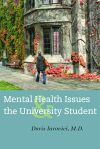Guest post by Doris Iarovici
Is mental health among college students continuing to decline, as various headlines suggest? This year’s “The American Freshman: National Norms 2014” survey, released at the beginning of February, again found “record” lows. Among the more than 150,000 first-year students from more than two hundred universities, only about half—the lowest number since the survey began—rated their emotional health as “above average or highest 10%.” And nearly 10 percent reported “frequently feeling depressed in the past year,” a 3 percentage-point increase over five years ago. An article in the Chronicle of Higher Education suggested that this is significantly higher than in the general population, where the CDC cites a nearly 5% prevalence rate of depression among 18-to-39-year olds. Are college students really more depressed on average than young adults in general? If so, what will it take to reverse the trend?
Feeling frequently depressed as a college freshman may or may not be equivalent to having depression, an illness that can interfere with both academic and social functioning. The CDC data relies on validated, more extensive depression screening questionnaires, while the freshman survey asks students to bubble in “frequently,” “occasionally,” or “not at all” to the item “felt depressed” (among other items such as “was bored in class,” or “discussed religion”). But the National Norms survey is a powerful snapshot which also captures other concerning trends. For example, fewer students socialized in person with peers, as they spent more time on social media. Research has shown that in the college population, loneliness is a risk factor for depression and for poorer physical health, and that loneliness and relationship difficulties are main contributors to suicidal thinking among students.
In my clinical experience working with the college population, there’s a cultural reluctance to admit vulnerability to, or discuss problems with, one another. Expectations are high that college will be fantastic; when it seems otherwise, students assume the fault lies within them. Difficulties then tend to surface when they’ve grown more severe, as when a classmate cuts herself or someone is taken to the emergency department because of intoxication. And this reinforces the myth that mental health is an all-or-nothing quality.
In fact, like physical problems, emotional problems occur on a spectrum. Helping young adults understand this—and university administrators plan for this—might help create healthier communities. The American Freshman survey also notes that more students are turning to counseling, and it’s certainly critical to ensure that schools have adequate clinical resources in place to meet student need. But in addition, programs that address the campus community as a whole are essential in addressing—and exposing—the spectrum of emotional issues. Workshop-style sessions on stress management, relationships, and meditation, for example, open to the entire student community and not just to counseling center patients, begin to provide a more realistic view of the universality of some emotional difficulties. Surveying students anonymously about their emotional health allows some assessment of emerging adult mental health, but creating forums were they can share stories of recovery and resilience might begin to more accurately portray student emotional health on campus.
 Doris Iarovici, MD, is a psychiatrist at Duke University Counseling and Psychological Services and the author of Mental Health Issues and the University Student, published by Johns Hopkins.
Doris Iarovici, MD, is a psychiatrist at Duke University Counseling and Psychological Services and the author of Mental Health Issues and the University Student, published by Johns Hopkins.
